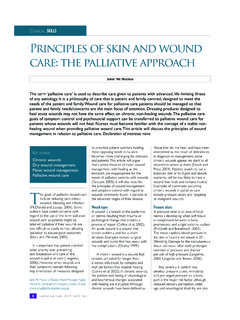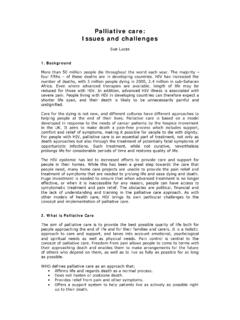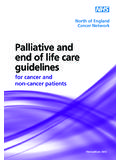Transcription of Prevention of Pressure Damage for Palliative and End of ...
1 Prevention of Pressure Damage for Palliative and End of Life Patients The skin is one of the first organs to fail in Palliative and end of life patients. This may lead to Pressure Damage that is unavoidable despite optimal Pressure relieving interventions. This does not mean that skin deterioration should be accepted by nurses (Beldon 2011). The principles listed below are adapted from SCALE 2009, and identify key considerations in practice with an aim to prevent Pressure Damage and support patient comfort and dignity. The flow chart below reflects Preventing Pressure Damage in adults. NICE guidance (2014) but underpins specific considerations for Palliative and end of life patients.
2 The notes overleaf provide further detail adapted from SCALE, Skin Changes at Life s End (2009) to also support care of skin at end of life. Identification of Palliative and end of life patientsAim to anticipate Pressure damageCommunicate and record patient goals of careComplete documentation / SSKIN documentationAnticipate disease trajectory and plan for impact of symptom management and co-morbiditiesSignpostingSpecialist adviceIdentify when healing may be achieved or when Pressure Damage may be unavoidableConsider Kennedy UlcersHolistic individualised care psychological/emotional/spiritual of end of life goalsRobust documentation of all communicationEducation/evaluations with patient.
3 Family and carersRepositioning at end of life should depend on patients wishesComfort and dignity even if in conflict with best practice guidelinesIt requires a common sense approach based on individual and cultural circumstancesPathwayPrevention of Pressure Damage in Palliative and End of Life Patients References:- the Beldon. P. (2011) Managing skin changes at life s end. Wound Essentials 6: 76-9 Westwood. R. (2014) The principles behind end of life care and the implications for patients skin. Journal of Community Nursing. Vol. 28. No 3 pgs. 58-64 Key principles- adapted from SCALE 2009 1.
4 Physiological changes that occur as a result of the dying process (weeks to days) may affect the skin This may manifest as observable objective changes in skin colour, turgor, or integrity, or as subjective symptoms such as localized pain. These changes can be unavoidable and may occur despite the application of appropriate interventions that meet or exceed the standard of care. 2. The plan of care and patient response should be clearly documented and reflected in the patient record. The impact of interventions should be assessed and revised as appropriate. 3. Patient-centred concerns should be addressed including pain and activities of daily living.
5 A comprehensive individualised plan of care should not only address skin changes and any co-morbidity but any patient concerns that may impact on quality of life including physiological and emotional issues. 4. Skin changes at life s end are a reflection of compromised skin (reduced soft tissue perfusion, decreased tolerance to external insults, and impaired removal of metabolic wastes). 5. Expectations around the patient s end of life goals and concerns should be communicated among the members of the interprofessional team and the patient s circle of care. The discussion should include the potential for SCALE including other skin changes, skin breakdown, and Pressure Damage .
6 6: Risk factors symptoms associated with SCALE may include: Weakness, progressive limitation of mobility, suboptimal nutrition including loss of appetite, weight loss, cachexia, low serum albumin/pre-albumin and low haemoglobin as well as dehydration Diminished tissue perfusion, impaired skin oxygenation, decreased local skin temperature, mottled discoloration, and skin necrosis Loss of skin integrity from any of a number of factors including equipment or devices, incontinence, chemical irritants, chronic exposure to body fluids, skin tears, Pressure , shear, friction, and infections Impaired immune function. 7: A total skin assessment should be performed regularly and document all areas of concern consistent With the wishes and condition of the patient.
7 8: Consultation with a specialised healthcare professional is recommended for any skin changes Associated with increased pain, signs of infection, skin breakdown (when the goal may be healing), and whenever the patient s circle of care expresses a significant concern. 9: Prevention is important for well being, enhanced quality of life and to avoid unplanned medical consequences for end of life care. 10:Patients and concerned individuals should be informed regarding SCALE and the plan of care. Kennedy Ulcers A Kennedy ulcer is a Pressure ulcer that some people develop as they are dying. It usually presents on the sacrum and can appear like a pear or butterfly.
8 The borders are irregular and may be red, yellow or purple. It has a sudden onset and associated with imminent death. Although further research is required it may be caused by a blood perfusion problem and may reflect what is going on in the body as part of the dying process. It is unlikely that a Kennedy ulcer will heal but individualised care can aim to minimise further Damage .









